#Nedor Publishing
Explore tagged Tumblr posts
Text
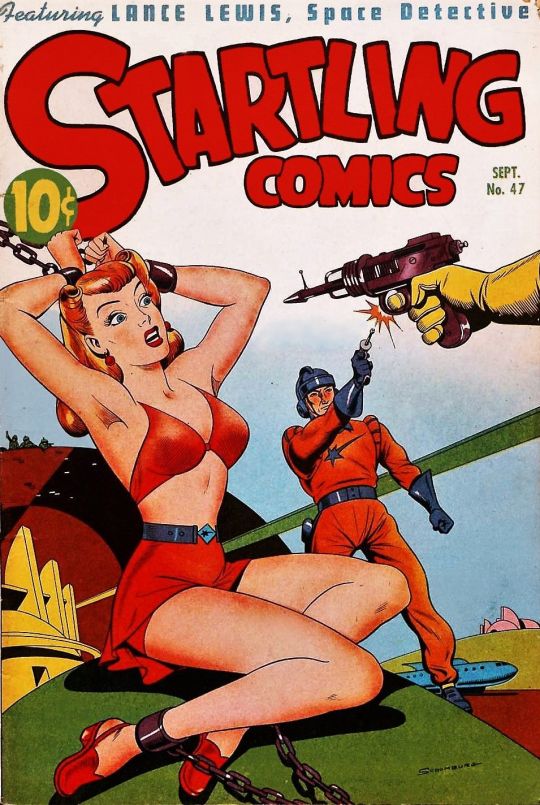
STARTLING COMICS (vol. 1) #47 (September, 1947). Cover by Alex Schomburg.
"Honest, Doc Wertham, boys are only buying these comics for the space ships and the ray guns!"
#Startling Comics#Lance Lewis Space Detective#Lance Lewis#Marna#ray guns#space ships#science fiction#Nedor Publishing#Golden Age comics
9 notes
·
View notes
Text
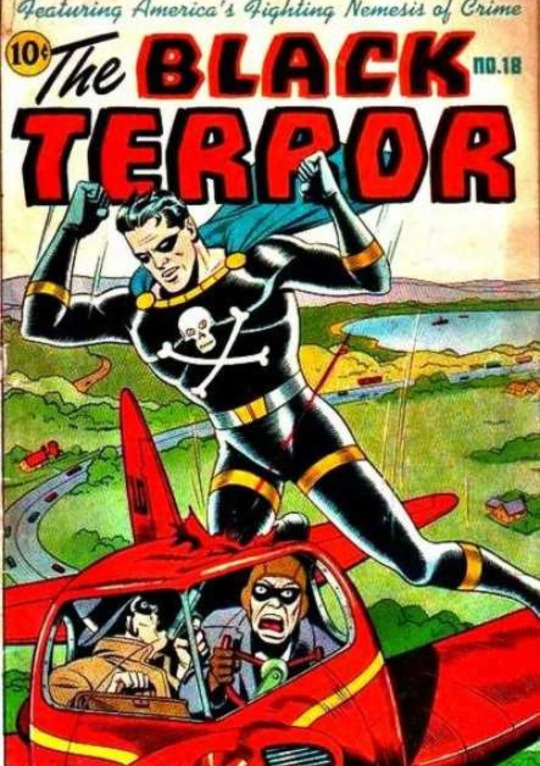

Here are 2 public domain superheroes,Black Terror and Kid Terror from nedor publishing
3 notes
·
View notes
Text
Wonder Comics #12-16 (comic books, 1947-1948)
.
Title featured a 5 issue run of bondage covers in the 1940s

.

.

.

.

.
Read for free at
Modern reprint

0 notes
Link
#coo coo comics#victor pazmino#nedor publishing#standard comics#golden age comics#geek gifts#man cave#she shed#comics for sale
0 notes
Text
Episode 157 - Public Domain Superheroes
You asked for it, so in this special bonus episode we’re talking about Public Domain Superheroes! We discuss the Golden Age of Comics, masked adventurers, copyright, crossovers, and more! Plus: Time Eggs!
You can download the podcast directly, find it on Libsyn, or get it through Apple Podcasts, Stitcher, Google Podcasts, or your favourite podcast delivery system.
In this episode
Matthew Murray | Carol Borden
Things We Read (or tried to…)
Project Superpowers (Wikipedia) by Jim Krueger, Alex Ross, Doug Klauba, Stephen Sadowsk, and Carlos Paul
Masks, vol. 1 by Chris Roberson, Alex Ross (Artist), Dennis Calero (Artist) Jae lee
See all the covers
Miss Fury: The Minor Key by Corinna Sara Bechko and Jonathan Lau
Swords of Sorrow (Women in Comics Wiki) by Gail Simone and so many others
Superheroes and Masked Adventurers (all links are to Wikipedia)
Plastic Man
Captain Marvel (DC Comics)
Captain Marvel (Marvel Comics)
The Shadow
The Spider
Miss Fury
Miss Fury and Miss Mills (article by Carol Borden on the Cultural Gutter)
Miss Fury Cut Outs
Miss Masque/Masquerade
Kato
Green Hornet
Red Sonja
Thor (Marvel Comics)
Thor in comics - DC Comics
Hercules (DC Comics)
Hercules (Marvel Comics)
Zeus (DC Comics)
Zeus (Marvel Comics)
Beowulf (DC Comics)
Beowulf (Earth-616) (Marvel Fandom Wiki)
Bucky Barnes
Black Terror (and Tim!)
Daredevil (Lev Gleason Publications) (The Death Defying 'Devil)
Jonah Hex
The Invaders
All-Star Squadron
The Twelve
Airboy
Fighting Yank
Dynamic Man
Ghost (Public Domain Super Heroes Wiki)
Cat-Man and Kitten
Irene Adler
Dejah Thoris
Green Lama
Zorro
Black Bat
Purgatori
Chastity
Lady Zorro (ComicVine)
Vampirella
Jane Porter/ Lady Greystoke
Pantha (ComicVine)
Eva, Daughter of Dracula (ComicVine)
Other Media We Mentioned
Wide Sargasso Sea by Jean Rhys
Winnie-the-Pooh by A. A. Milne and E. H. Shepard (Wikipedia)
Night of the Living Dead (Wikipedia)
Superman (1940s animated film series) (Wikipedia)
The Great Comic Book Heroes by Jules Feiffer
The Amazing Adventures of Kavalier & Clay by Michael Chabon
Spicy Library Stories
Sherlock Holmes & Kolchak the Night Stalker: Cry of Thunder by Joe Gentile, Andy Bennett, and Carlos Magno
The Incredible Hercules (Wikipedia)
Aliens vs. Predator (comics) (Wikipedia)
Freddy vs. Jason (Wikipedia)
X-Men 2099 (Wikipedia)
Justice League Unlimited (Wikipedia)
Justice League Action - Jonah Hex’s Space Rodeo! (YouTube)
Archie vs. Predator (Wikipedia)
FemForce (Wikipedia)
Tom Strong (Wikipedia)
Public domain characters show up staring in issue #11, there’s also some Terra Obscura miniseries that focus on these characters.
Savage Dragon (Wikipedia)
Next Issue Project (Wikipedia)
Miss Fury: Sensational Sundays by Tarpe Mills
Call of Cthulhu (role-playing game) (Wikipedia)
Achtung! Cthulhu (Role-Playing Game) (H.P. Lovecraft Wiki)
Links, Articles, and Things
The Cultural Gutter
Monstrous Industry
Fox Spirit Books
Episode 155 - Literary Fan Fiction
Public Domain (Wikipedia)
Public Domain Day 2022
Public Domain Comic Books (TVTropes)
Public Domain Super Heroes Wiki
Creative Commons (Wikipedia)
5 Great Public Domain Superheroes (& 5 Worst)
Superman (ice cream flavor) (Wikipedia)
National Comics Publications, Inc. v. Fawcett Publications, Inc.
Golden Age of Comic Books
Canadian Whites (Wikipedia) (Canadian WWII-era comics)
The Canadian Captain Marvel Comics #10
Fox Feature Syndicate (Wikipedia)
Crestwood Publications (Wikipedia)
Standard Comics (Wikipedia (Nedor Publishing)
Quality Comics (Wikipedia)
Fawcett Comics (Wikipedia)
Charlton Comics (Wikipedia)
WildStorm (Wikipedia)
The 10 Best Crossovers in Archie Comics
From KISS to 'The Addams Family': The Best 'Scooby-Doo!' Crossovers You Just Have to See
12 Strangest Scooby-Doo Crossovers, Ranked
Eclipse Comics (Wikipedia)
America’s Best Comics (Wikipedia)
Dynamite Entertainment (Wikipedia)
Alex Ross (Wikipedia)
Afraid Of Cock
The printed cover to Justice Society of America #7
‘Zorro’ Licensor, in Role Reversal, Faces Trial for Copyright Infringement
Black Legion (political movement) (Wikipedia)
Chaos! Comics (Wikipedia)
Give us feedback!
Fill out the form to ask for a recommendation or suggest a genre or title for us to read!
Check out our Tumblr, follow us on Twitter or Instagram, join our Facebook Group, or send us an email!
Join us again on Tuesday, September 6th we’ll be discussing the format of Audio Book Fiction! (This episode will probably become “What is a book? Part 2”
Then on Tuesday, September 20th we’ll be discussing the winner of our “we all read the same book” poll and discussing Hurts So Good: The Science and Culture of Pain on Purpose by Leigh Cowart!
5 notes
·
View notes
Text




BLACK TERROR
The Black Terror was published by Nedor Comics and was it most popular super-hero title. He first appeared in Exciting Comics (January 1941) the later in his own self-titled comic until 1949.
In his secret identity as pharmacist Bob Benton his developed a chemical formula he called "formic ethers" that which gave him superpowers. His sidekick was neighborhood teen Jesse Pinkma—- I mean Tim Roland. They worked together known as the "Terror Twins".
5 notes
·
View notes
Text
PD Character 02: The Black Terror

Ben Benton, The Black Terror
Black Terror was created by Richard E. Hughes for Nedor publishings Exciting Comics no: 09 (Jan 1941) the character quickly gained an audience and became one of their more popular characters and on his back Nedor made Exciting Comics a monthly magazine.
Ben was a Pharmacist who formulated a chemical he called ‘Formic Ethers’ which gave him various superpowers of which he used to fight crime alongside his kid sidekick (they were all the rage back then lol) Tim Roland and together they were the Terror Twins. Ben also had a love interest, Secretary Jean Starr, much like Lois Lane, she had no romantic interest in Benton but fancied Black Terror before eventually discovering they were one and the same.
Black Terror had a rogues gallery of villains from Nazis to mad scientists like Thorg famed creator of the million dollar death ray and of course the femme fatale Lady Serpent who would use her hypnotic glance to have you under her spell.
After the 27th issue Black Terror didn’t fade away he just went to greener pastures starring in comics for many publishers/companies such as: AC Comics’ Americomics, a one time appearance in Darkline Comics’ Dark Adventures written by Vic Peterson as well as Eclipse Comics, Image Comics and of most recent appearances Dynamite Entertainment starred along side many other golden age heroes in Project Superpowers by Jim Krueger and the great Alex Ross (Yes that Alex Ross) before getting his own spinoff that sadly was cancelled after only 14 issues.
Ben Benton, Black Terror, Tim Roland and all the characters within their stories are in the PD. You are free to use, remake, redesign, retell, mess about with these characters at your own whim and glory just remember ‘Wherever evil lurks, whatever shadow shrouds it they will smell the formic ethereals of THE BLACK TERROR’ yeah doesn’t sound great to me either lol.
6 notes
·
View notes
Photo

Joe Yank Published in may 1952 By Better/Nedor/Standard/Pines Publications #joeyank #silveragecomics #comic #comics #powercomics #comicscollection #comicscovers #covercomics #vintagecomic #comicsvintage #comicsbooks #comicsbookcovers #comicsart #comicsandcoffee #comics4sale #warcomics #warcomic #marvelcomics #marvel #dc #dccomics #comicshop #comicsespañol #comicmexicano #comicsketch #comicseries #comicstyle #vintagecomicsbooks #collectorscomics #grantscomics (en USA) https://www.instagram.com/p/Chmy3mqK7yq/?igshid=NGJjMDIxMWI=
#joeyank#silveragecomics#comic#comics#powercomics#comicscollection#comicscovers#covercomics#vintagecomic#comicsvintage#comicsbooks#comicsbookcovers#comicsart#comicsandcoffee#comics4sale#warcomics#warcomic#marvelcomics#marvel#dc#dccomics#comicshop#comicsespañol#comicmexicano#comicsketch#comicseries#comicstyle#vintagecomicsbooks#collectorscomics#grantscomics
1 note
·
View note
Text
Marvel's Captain Marvel: A Legacy of Failed Relaunches
This piece is about the history of the Captain Marvel name in superhero comic books. First we have to start with the originator, then how it was shut down, then we can get to how it was stolen and how it's been handled since. I will not be getting in to Miracleman/Marvelman, since that is a whole other layer of convoluted.
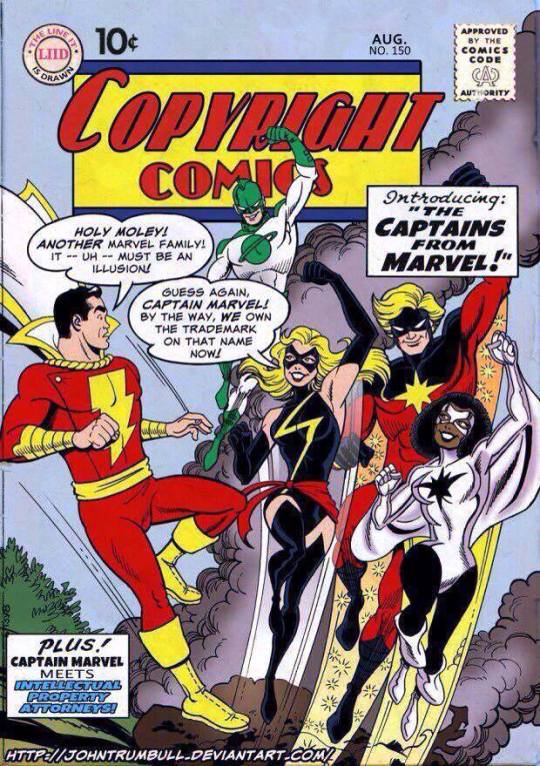
Fawcett Publications was a publisher of magazines in the 1920s and 30s. They wanted to break into the comic book business after seeing the insane success of Superman starting in 1938. So in 1940 writer Bill Parker and artist CC Beck came up with a superhero for this purpose. The character was to be called Captain Thunder and debut in Flash Comics #1. However, All-American Periodicals beat them to the punch with their own Flash Comics #1 with a cover date of January 1940, debuting the Flash, Hawkman, and other characters. So Fawcett switched the title to Thrill Comics. Which they couldn't use either when Standard/Nedor launched Thrilling Comics #1 with a cover date of February 1940. I guess even the "ing" was too close for trademark comfort. January 1940 also saw the first issue of Fiction House's Jungle Comics, which had a minor backup feature starring Captain Terry Thunder. So when their character was finally unveiled to the public, he was Captain Marvel and appearing in WHIZ Comics #2.
The parallels to Superman were there off the bat and intentional. The first cover features Captain Marvel throwing a car, in reference to the iconic Action Comics #1, but one-upping it. Their powers, costumes, and adventures were somewhat similar. Captain Marvel arguably improved on the Superman formula. Instead of the grown, nerdy Clark Kent, Captain Marvel's secret identity was the child Billy Batson. Rather than looking up to Superman, kids could put their selves in Billy Batson's shoes. The art of CC Beck and others was also more cartoony and the stories more outlandish and fun. While Superman was dealing with corrupt politicians and domestic abusers, Captain Marvel was fighting the moon and hanging out with anthropomorphic tigers.
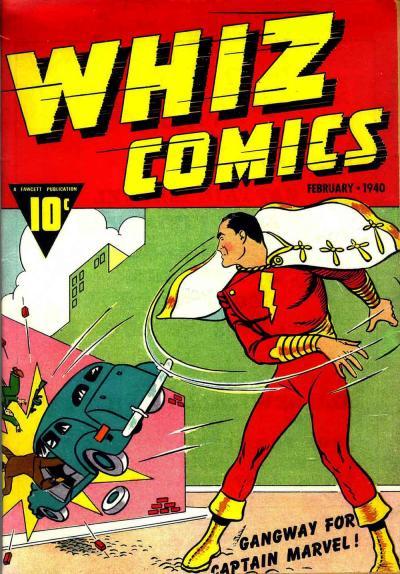
Captain Marvel replicated the success of Superman, and for a while even outsold the poster boy of comic books. The character's success led to Fawcett creating a whole line of comics and superheroes like Bulletman, Spy Smasher, Minute-Man, Ibis the Invincible and so on in the titles Nickel Comics, Wow Comics, Master Comics, etc. Captain Marvel started multiplying himself with spinoff characters Captain Marvel Jr. and Mary Marvel (before DC created Supergirl). The publisher experienced great success through the 1940s.
This success bothered some people, namely competitor National (today's DC Comics). They had success earlier shutting down Fox Feature Syndicate's character Wonder Man for being too close to Superman. They even did the same thing to Fawcett with their character Master Man. Starting in 1941 National took Fawcett to court over Captain Marvel. The lawsuit and all its subsequent appeals lasted all the way to 1951. Meanwhile Superman was ripping off elements of Captain Marvel along the way, like starting to actually fly, Lex Luthor becoming a bald mad scientist (like Dr. Sivana), and introducing the adventures of Superboy akin to Captain Marvel Jr. The long legal struggle and the waning superhero popularity of the 1950s led to Fawcett giving up on the case and shutting down their entire comics line in 1953.
Of course, having won, DC took the opportunity to pull over Fawcett's talent and put them to work on Superman. DC then ended up licensing Fawcett's characters in the 1970s. Captain Marvel has been fully integrated to the DC Universe through the years, for better or worse.
There is just one ironic hiccup though. While Captain Marvel lay dormant in the 1960s, the trademark lapsed. Another comic publisher by the name of Timely Comics had went through a few eras and name changes to Atlas Comics and then to Marvel Comics. Marvel was becoming a major force in the early 1960s thanks to Stan Lee, Jack Kirby, and Steve Ditko. Publisher Martin Goodman demanded that they snatch up the trademark to Captain Marvel. Fitting I suppose given the name of the company.
So in December 1967 Marvel's version of Captain Marvel debuted in Marvel Super-Heroes 12. Rather than a Superman-like character, this version was Mar-Vell, an alien warrior who was tasked to spy on Earth but then decided to protect humanity. The stories were light science fiction fare.
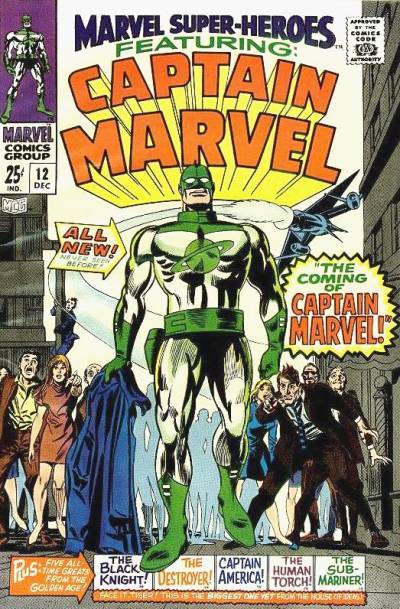
This Captain Marvel would not become a sales juggernaut like Fawcett's. Marvel has to maintain their right to the trademark at least every two years though. So this has lead to dozens of relaunches and different characters under the Captain Marvel name.
This is their legacy of failure.
After two appearances in Marvel Super-Heroes (12-13) Captain Marvel received his own self-titled comic in May 1968. From the first appearance through the fourth issue of the series, Gene Colan drew the character and Roy Thomas wrote him. Then not even a year in new creative team Arnold Drake and Don Heck hop on. Other creators like Gary Friedrich, Dick Ayers, and Archie Goodwin rotate through. The original green and white costume has a simplistic design that has become retroactively classic, but is really not too special.
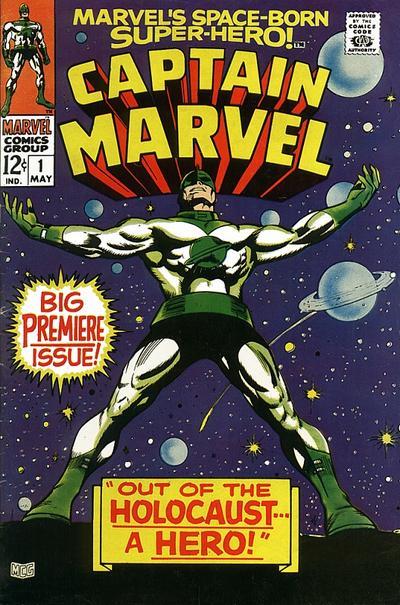
With issue 17 in October 1969, Roy Thomas comes back and is joined this time by Gil Kane. The pair introduce a new costume and the unique dynamic of Captain Marvel playing switcheroo with perennial sidekick Rick Jones. The quality of the book vastly improves, but it only gets the chance to show it off for three issues.
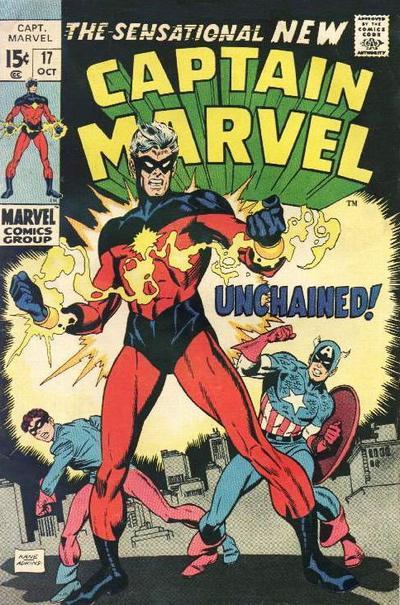
After a six month hiatus, Captain Marvel resumes with issue 20 and the same creative team from before. This time they only get to pump out two issues. The book will now be bimonthly for the most part from here on out.
The character would feature prominently in the classic Kree/Skrull War storyline in Avengers, also written by Roy Thomas. This kept him relevant through 1971 even without a book.
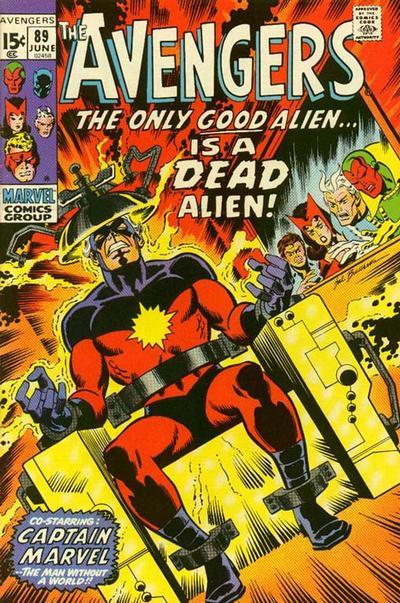
And Mar-Vell is back again two years later in 1972 (recall the trademark rules). This time we have three uninspired issues written by three different writers. The only notable piece here is that they're drawn by Wayne Boring. Who was one of the definitive Superman artists of the 1940s and 50s in comic books and strips. In 1967 DC kicked him out, as they had done with most of their iconic Golden Age artists. Super fan and historian Roy Thomas hired him to do a few jobs for Marvel in the 70s. It's cool to see, but his style honestly was out of date by this point. The irony of these past two relaunches is that both returning issues use the cover text "the hero who wouldn't die!" The irony will become evident in a bit.
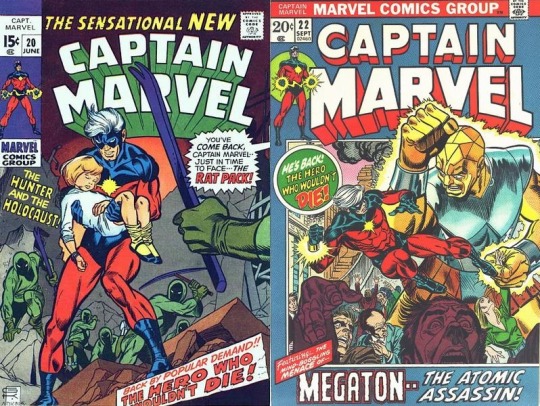
By this point DC has licensed the original Fawcett Captain Marvel. Due to Marvel's trademark usage, DC has to title the comic Shazam (the catchphrase Billy Batson uses to transform into the hero). Shazam runs from 1973 through 1978 and then the character moves to anthology backups. Superman even introduces the Big Red Cheese on the cover of the first issue. Within the pages of the comic, the character is still allowed to be called Captain Marvel. This alleged confusion has caused anxiety over the years for DC and with the New 52 reboot in 2011 they tried to officially change the icon's name to Shazam.
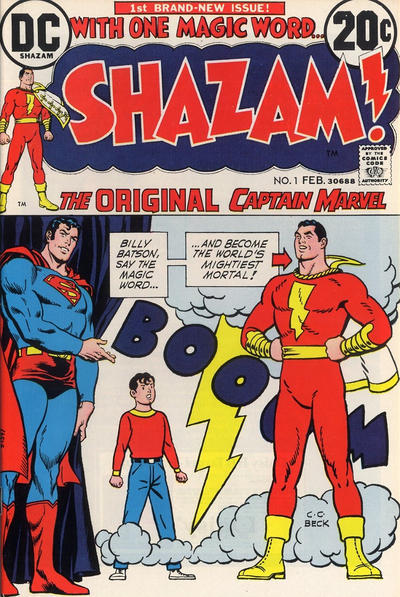
With issue 25 in 1973 Captain Marvel finally becomes a must-read comic when a young Jim Starlin jumps on board as artist. He had previously written and drawn fill-in issues of Iron Man that introduced the characters Thanos and Drax the Destroyer. He brought those characters with him and began writing as well, giving fans the iconic Thanos War arc. Starlin sticks around for less than a year. His final issue is 34, where Mar-Vell fights Nitro and the infamous cover text describes him as "the man who killed Captain Marvel." It's originally just supposed to be a sensational lie as is the tradition.
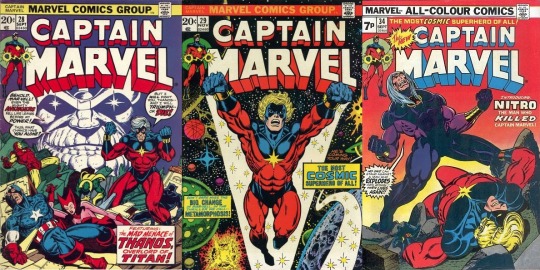
With Starlin gone, Captain Marvel still continues to issue 62 in 1979. Al Milgrom and Pat Broderick draw most of this run. Steve Englehart, Scott Edelman, and Doug Moench handle the writing. Nothing truly memorable or relevant happened, though by this point there were Mar-Vell fans who surely enjoyed it.
Supporting character Carol Danvers also got superpowers and got a spinoff title that ran two years. Mostly written by Chris Claremont. Ms. Marvel would have her own too-late creative reinvention in issue 20 thanks to artist Dave Cockrum. This book was arguably better than the book it spun out of at this point. Carol Danvers will become important again in this saga, but for the time being Claremont pulls her way to be an occasional presence in his vast X-Men run.
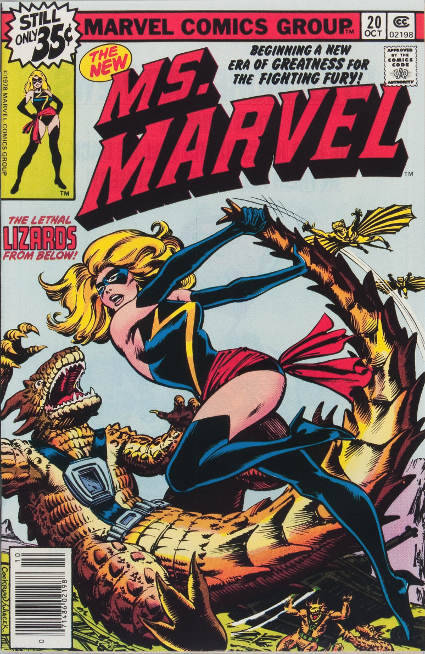
Captain Marvel was cancelled prematurely, so Marvel launched a new volume of Marvel Spotlight to pump out inventory issues. Captain Marvel appeared in Marvel Spotlight 1-4, and 8. Of curiosity is that Steve Ditko and Frank Miller drew the last two issues.
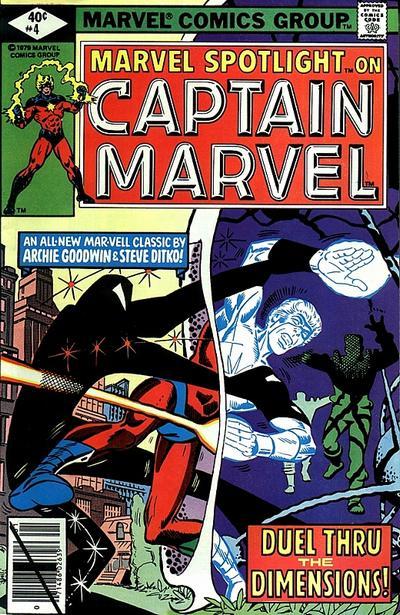
Outside of a few appearances, Mar-Vell doesn't make a major appearance between September 1980 and April 1982. When Jim Starlin was offered to write and draw the first installment of the Marvel Graphic Novel series and kill off a major character. One can presume he wasn't allowed to choose Spider-Man. He went with Captain Marvel, following up from his final issue on the series and revealing that the fight with Nitro gave him cancer. He died surrounded by all his fellow heroes and the book is a genuine emotional classic. It solidifies Mar-Vell as a legend, even if his original series never truly got him to deserve that reputation.
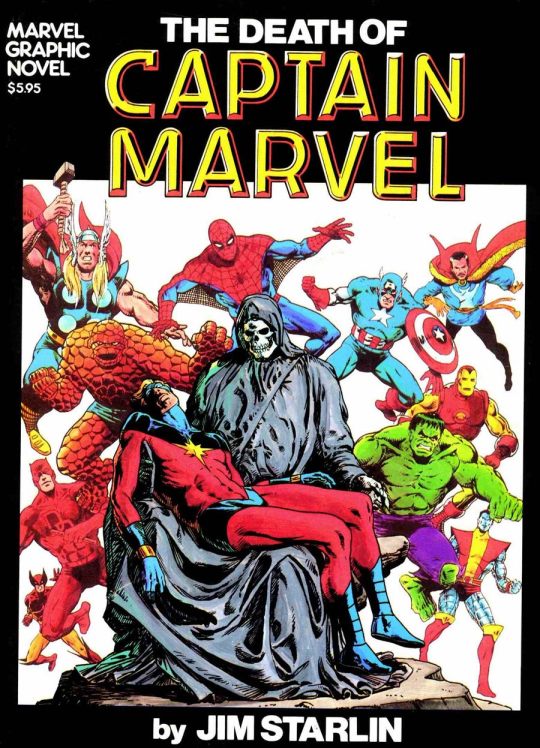
Mar-Vell would be featured in a reprint series titled The Life of Captain Marvel in 1985 focusing on the Starlin run. A three issue flashback series to his green and white era was published in 1997.
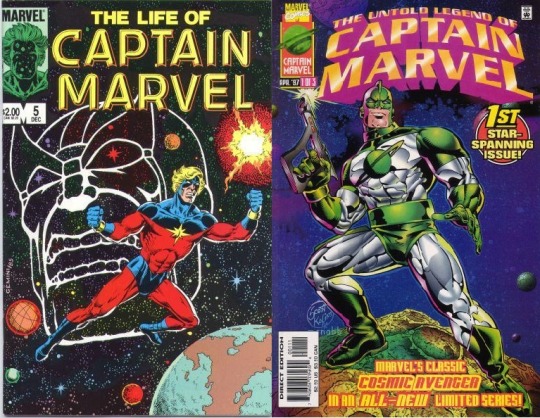
They need to maintain the trademark though, right? Enter Monica Rambeau in Amazing Spider-Man Annual #16 the same year. Her connection to Mar-Vell was nonexistent, but she took on the Captain Marvel name regardless. Creator Roger Stern carried her over to his legendary Avengers run and she even lead the team for a period. Monica has had tons of memorable appearances since, such as the brilliant Nextwave: Agents of HATE.
Monica would receive solo one-shots in 1989 and 1994. Both by the creative team of Dwayne McDuffie and M.D. Bright.
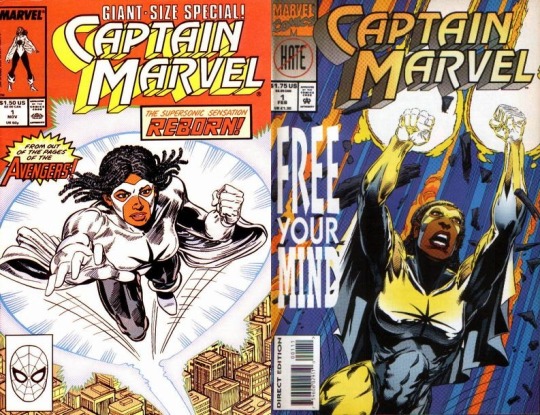
The third Marvel character to go by Captain Marvel was Genis-Vell. Originally introduced in Silver Surfer Annual #6 as Legacy, Genis is Mar-Vell's bastard child. Genis gets his father's Nega Bands and even is linked to Rick Jones. He got his own series written by Fabian Nicieza in late 1995 that was cancelled prematurely after six issues. In Avengers Unplugged #5 Genis officially takes the Captain Marvel name from Monica, who then suffers through several code names over the years.
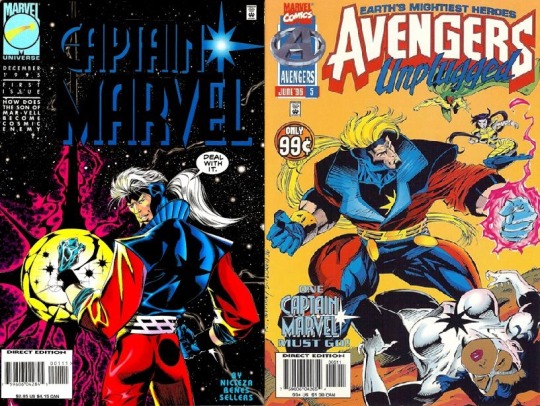
After disappearing for about two years, Genis pops up again prominently in the Avengers Forever maxiseries. This launched a 2000 series written by Peter David and drawn by ChrissCross. The series was a critical darling and cult hit, but sales weren't perfect.
To try and boost sales, the book was relaunched in 2002 as part of the U-Decide Campaign. Which was a (marketing ploy) bet between David, Bill Jemas, and Joe Quesada. Fans helped to decide which of three books would survive. It helps that the other two books (Marville and Ultimate Adventures) were absolute trash, but Captain Marvel handily won. It lasted another 25 issues to bring the entire run to 60 issues. During the run, the fourth Captain Marvel Phyla-Vell is introduced as Genis' sister/clone. She uses the name briefly and then becomes Quasar and then Martyr in other stories. Genis eventually goes crazy, then dies.

In 2008 as part of the Secret Invasion crossover, Mar-Vell seems to come back to life in a self-titled miniseries. However, it's revealed that this character is a Skrull with fake memories.
The Skrull fake dies, but is able to pass on his wishes to the Kree hero Noh-Varr. Who was previously known as Marvel Boy, but then becomes Captain Marvel during the Dark Reign era. After discovering he's being manipulated, he abandons the Dark Avengers and takes on the Protector identity.
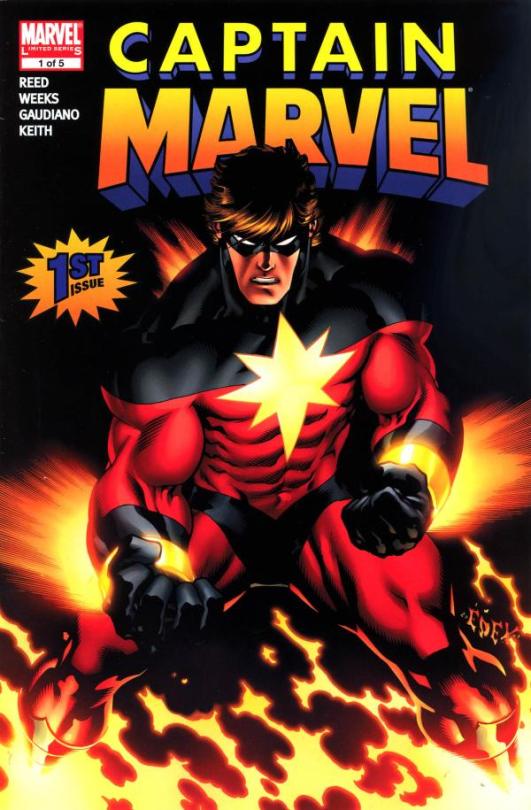
While the Avengers stock is rising in the 2000s thanks to Brian Michael Bendis, Carol Danvers is back as Ms. Marvel and her mission is to become the prominent hero she thinks she can be. To really promote her, in 2012 Marvel gives her the Captain Marvel name, redesigns her costume, and launches a new title. Kelly Sue DeConnick will shepard the character for the next few years. This series only lasts 17 issues.
By 2012 Marvel has now entered their relaunch trigger happy era. So in 2014 Captain Marvel is relaunched while keeping the same writer. This volume is even shorter at 15 issues.
As a tie-in to the alternate reality event Secret Wars in 2015, Carol Danvers gets her own miniseries still by KSD.
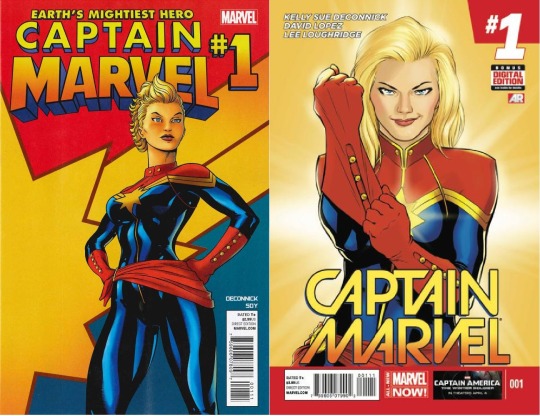
Coming out of Secret Wars, Captain Marvel gets another volume. This one lasts only 10 issues. Marvel brings in TV writers Tara Butters and Michele Fazekas. They leave halfway through and are replaced by Christos and Ruth Gage. The character is significantly entangled in the divisive crossover event Civil War II around this era.
In 2017 another relaunch is due and Carol gets the slight title change to The Mighty Captain Marvel. Prose writer Margaret Stohl is the writer. This series lasts nine issues before being renumbered/retitled as part of Marvel's Legacy initiative. Still with Stohl, renumbered for only five issues.
A soon to be released one-shot tie-in to Infinity Countdown promises Carol adventuring with Monica and possibly Mar-Vell. Marvel has been subtly teasing Mar-Vell's genuine return again recently.
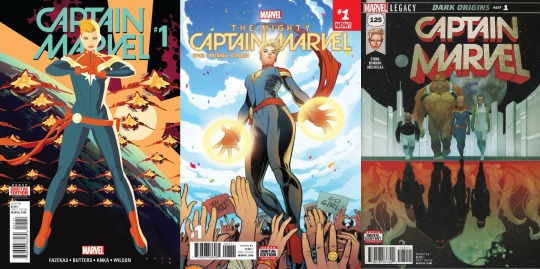
With a Captain Marvel movie starring Carol Danvers just around the corner, Marvel obviously needs to relaunch again (SIGH). July 2018 will bring The Life of Captain Marvel #1. Still written by Stohl, the series promises to retell Carol Danver's origin. So maybe they'll decide to relaunch it again after the origin arc is over.
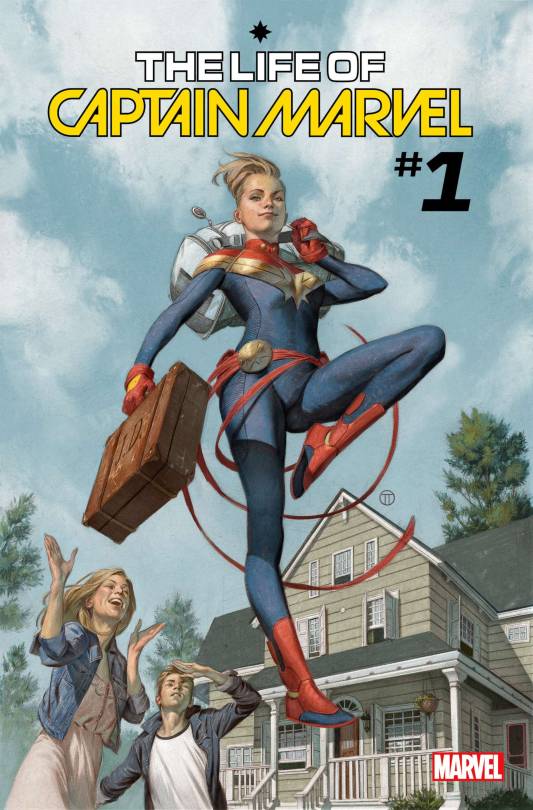
It's unclear whether DC would have been able to quickly grab the trademark back in the possibly free periods of 1984, 1987, 1992, 1998, and 2006. I don't know if the publication of collected editions fulfills the trademark requirements. If so, Masterworks and other collections could tick off some of those possible open spots.
To summarize, here are all of Marvel's Captain Marvel titles and relaunches:
Mar-Vell Marvel Super-Heroes 12-13 (December 1967-March 1968) Captain Marvel Vol 1 1-19 (May 1968-December 1969) Captain Marvel Vol 1 20-21 (June-August 1970) Captain Marvel Vol 1 22-62 (September 1972-May 1979) Marvel Spotlight 1-4, 8 (July 1979-September 1980) Death of Captain Marvel (April 1982) Life of Captain Marvel Vol 1 1-5 (August-December 1985) Untold Legend of Captain Marvel 1-3 (April-June 1997)
Monica Rambeau: Captain Marvel Vol 2 1 (November 1989) Captain Marvel Vol 2 1/2 (February 1994)
Genis-Vell: Captain Marvel Vol 3 1-6 (December 1995-May 1996) Captain Marvel Vol 4 0-35 (November 1999-October 2002) Captain Marvel Vol 5 1-25 (December 2002-September 2004)
Skrull Fake: Captain Marvel Vol 6 1-5 (January-June 2008)
Carol Danvers: Captain Marvel Vol 7 1-17 (September 2012-January 2014) Captain Marvel Vol 8 1-15 (May 2014-July 2015) Captain Marvel and the Carol Corps 1-4 (August-November 2015) Captain Marvel Vol 9 1-10 (March 2016-January 2017) Mighty Captain Marvel 0-9 (February-November 2017) Captain Marvel Vol 1 125-129 (December 2017-April 2018) Life of Captain Marvel Vol 2 1-? (September 2018-?)
*Dates used are cover dates.
#captain marvel#carol danvers#shazam#mar-vell#kree#genis-vell#monica rambeau#photon#pulsar#marvel#marvel comics#comics#comicbooks#comic books#dc#dc comics
54 notes
·
View notes
Note
TumblrFrostbite's Public Message: How many Golden Age characters lived on during the early and mid 1950's (besides Superman, Batman, Wonder Woman, Aquaman and Green Arrow)?
Here’s the thing you have to remember to understand this question: there was a time after World War II when superheroes were thought of as a wartime fad. Only a few of the biggies (and a few small fries who were printed in backups) stayed around and enjoyed continuous publication well into the 50s, when they experienced a revival in the middle part of that decade.

Here’s a character to include in your list as someone who got continuous publication well past the time you’d think: Blue Beetle. He was the star of Fox Publishing’s comics line, so they kept him alive long after the costume hero trend started to wind down, coasting on residual popularity from his enormous peak - Blue Beetle was published bimonthly until 1955. By the time he was finished, however, Blue Beetle’s Ancient Egyptian-derived powers were underplayed and he was more like a narrator of crime stories.

In his prime, there were Blue Beetle clubs, a radio show that often a top ratings getter. Hell...Blue Beetle is a very good candidate for my Dead Fandoms series. My favorite part of, ahem, Beetlemania is the “meet and greet with Blue Beetle” at the 1939 World’s Fair sponsored by Fox publishing.

Blue Beetle was easily in the top five most popular comic heroes of World War II, along with Superman, Sheena, Captain Marvel (who’s success in the 1940s is often overstated/overplayed by comic histories in my opinion, but it is based on something), the Black Terror, and Captain America and the original Human Torch, beloved because to quote Jules Pfeiffer, “every boy goes through a phase where he is a pyromaniac.”
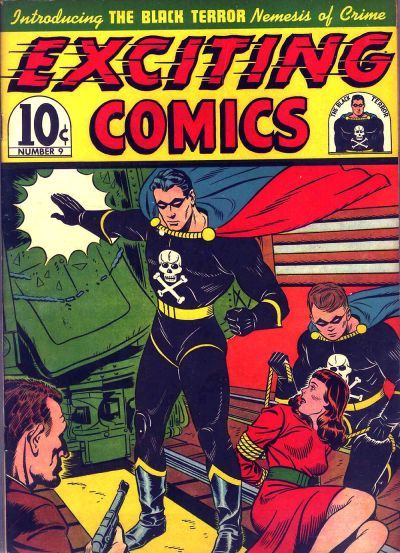
One character who only barely reaches into the cutoff point but who is still worth mentioning (his comics ended in 1949, which is shockingly late considering the immense drop in wartime popularity for superheroes) was Nedor comics’s Black Terror, easily one of the most popular characters of World War II. As Nedor went belly up, the character is in the public domain now.
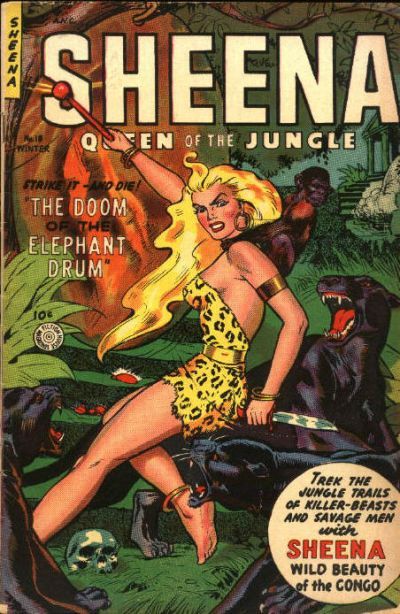
Another superhero who had continuous publication past the war into the 1950s was Sheena, Queen of the Jungle, who was published well into 1952, though the fact her comic was so infrequently published makes this a bit less impressive.

It’s interesting that you should mention Aquaman and Green Arrow; they had infrequent publication as backup characters (remember: in the old days, comics were like anthologies, and often had “backup” strips apart from the headliners), a category that also includes the Jerry Siegel created character Robotman, about a scientist who puts his brain into a robot and who teams up with a robot dog. The stories were surprisingly upbeat and light despite the fact the hero is a brain in a robot body cut off from his humanity. Despite the fact that he’s not often mentioned today, Robotman was a surprisingly durable backup, lasting long after the war into the time you mention.
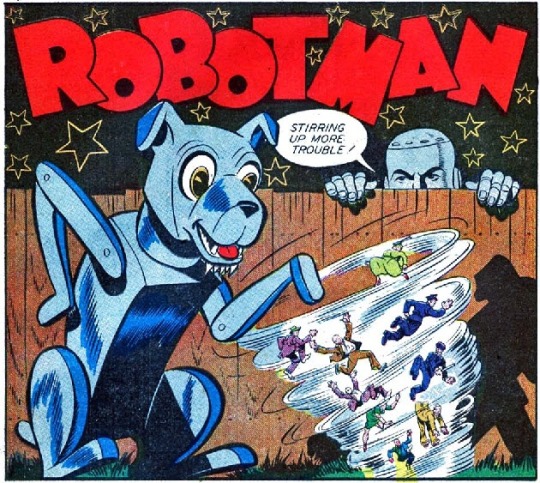
When talking about the minor league backup characters who never got their own comic, here’s a fun fact for you: we actually don’t know, with 100% certainty, who created Aquaman. Records were simply not kept, comics were uncredited, and most of the people involved are dead. The strongest case I’ve ever heard for the identity of Aquaman’s creator is Mort Weisenger, and I’ve often heard a fascinating explanation that the reason Aquaman had such durability as a backup character, despite his status as nobody’s favorite character, the Pavel Chekhov of the DC Universe, is that Mort Weisenger, was a DC editor, so he had the pull to keep his creation in publication. In other words, Aquaman is probably in the Justice League movie today because his creator was a big shot who had a soft spot for his own creation.

Unrelated aside: Here’s a question that I don’t think has ever been answered to my satisfaction, and to the best of my knowledge, was never even asked: what happened to the Golden Age Speedy, the sidekick of the Golden Age Green Arrow? Unlike the Earth-1 Roy Harper, he was often drawn as blonde instead of a redhead. He didn’t die in Crisis, but as we learned, people didn’t just “evaporate.” In theory, Golden Age Earth-2 Speedy should be alive today somewhere.
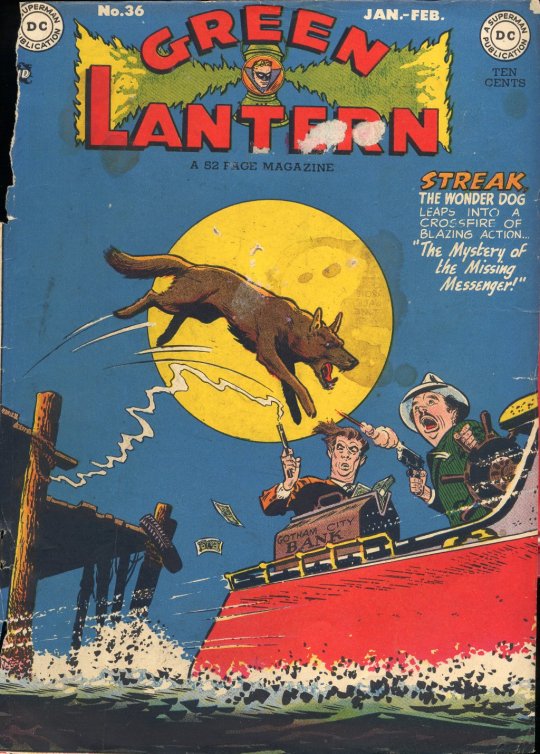
Also, here’s another character who didn’t enjoy continuous publication into the 1950s, but who’s comic did: Green Lantern. In the old days, distributors were suspicious of small numbered titles, so comics were kept going even after the hero left them. So Green Lantern eventually became a comic where the hero was forced out of it in favor of the more popular Streak, the brave dog, who got the cover.
138 notes
·
View notes
Text
Parque de zona franca viene con 4,000 Empleos
New Post has been published on https://www.tuempleord.do/2020/11/13/parque-de-zona-franca-viene-con-4000-empleos/
Parque de zona franca viene con 4,000 Empleos

El puerto DP World Caucedo desarrollará parques de zonas francas para manufactura con una capacidad de tres millones de metros cuadrados de terreno y generará cerca de 4,00 empleos directos en un período de dos años.
El anuncio lo realizó el director ejecutivo de la empresa, Ahmed Bind Sulayem, en el acto inaugural de la expansión del puerto que ahora aumenta la capacidad operativa de los contenedores de carga de 1.2 millones a 2.5 millones.
Los ejecutivos del puerto informaron que la creaci��n del parque de zonas francas servirá para atraer alrededor de 10 empresas extranjeras a República Dominicana y que ejecuten sus operaciones desde este país.
“Nuestro próximo objetivo es la creación de un parque de zona franca para la manufactura en la península de Caucedo. Cuando se concluya, el proyecto podrá atraer a muchas empresas, generando así miles de empleos, reforzando la economía del país y elevando la calidad de vida de las comunidades”, destacó Bind Sulayem.
Indicó que para esta iniciativa se tomará el ejemplo de una plataforma similar que la empresa desarrolló en Dubái, resaltando que tras la creación del parque República Dominicana contará con el puerto, la logística y la fabricación en una plataforma totalmente integrada. Agregó que en los planes de la empresa no sólo se incluyen proyectos de infraestructura, sino también de innovación, tecnología, administración y herramientas que ayudarán al país a tener mayores niveles de competitividad, así como el desarrollo de un hub de carga aérea en alianza con el Aeropuerto Internacional de Punta Cana, el cual brindará oportunidades a los exportadores e importadores dominicanos…SIGA LEYENDO
0 notes
Photo

Thrilling Comics #20 (September, 1941).
First appearance of the American Crusader, basically a Superman clone (complete with Milquetoast alter ego) who battles Ratzis on the homefront. That in itself is interesting, as America hadn’t entered World War ll yet, but you wouldn’t know it from reading this story.
7 notes
·
View notes
Text

Here is a public domain superhero,Pyroman from nedor publishing
0 notes
Photo

Before moving on, let's take a quick look at STARTLING COMICS. The publisher was Better Publications AKA Nedor Publishing AKA Standard Magazines. In other words, it was Ned Pines, the publisher of STARTLING STORIES, THRILLING WONDER STORIES, and some of the other pulps we've been discussing this week. All told, there were 53 issues of STARTLING COMICS published between 1940 and 1948. It was an anthology title, published all sorts of graphic stories. Pictured here is issue #49 -- dated January 1948 -- and featuring cover art by Alex Schomburg. https://www.instagram.com/p/B9af3_uHeWj/?igshid=m7y6q4vwwpnd
0 notes
Link
#coo coo comics#golden age comics#funny animals#nedor publishing#standard comics#comic books#geek gifts#man cave#she shed#comics for sale
0 notes
Photo

One of the first comic books put out by Pines Nedor Standard publishing in 1939 was Best Comics with newspaper strip reprints of the Red Mask, which some consider to be the first Black Masked mystery man of the jungle. In issues 2 through 4, he was recolored white or mixed for the covers, but he was intended to be Black, and printed like such in much of the issues’ interiors. https://www.instagram.com/p/B2rfSofhxNc/?igshid=1rel8tyatms7o
0 notes